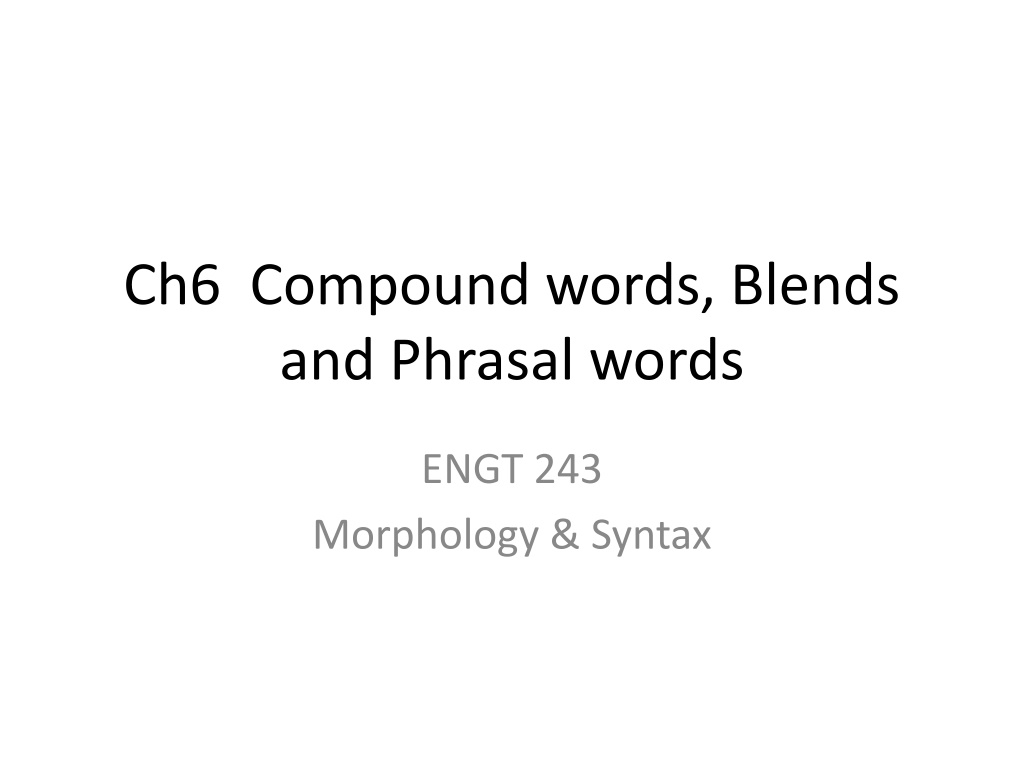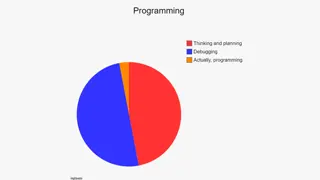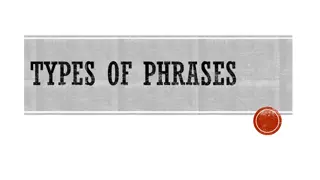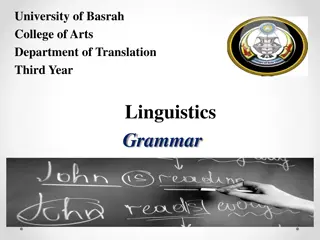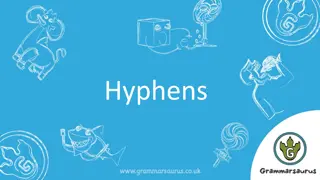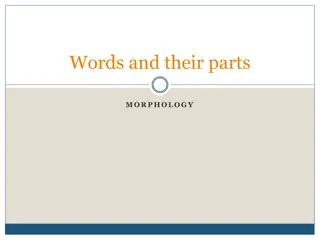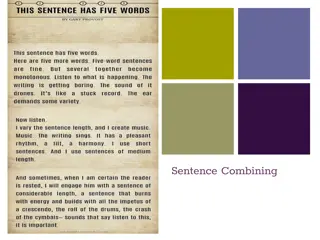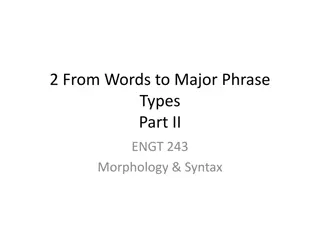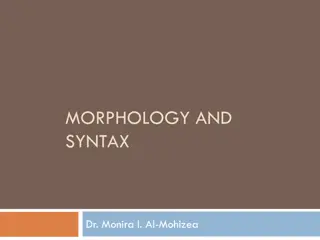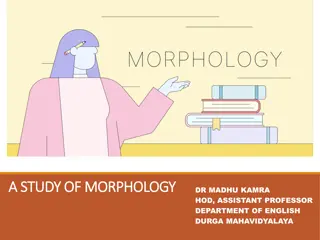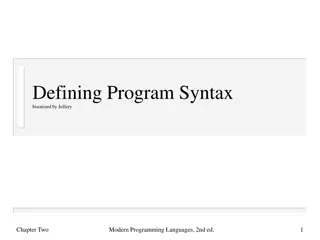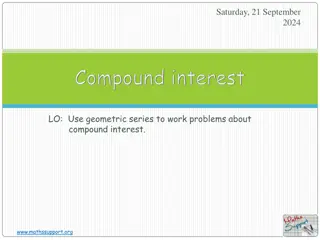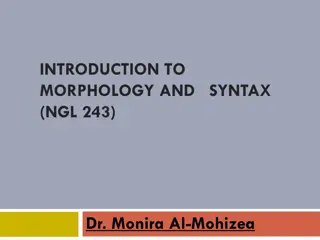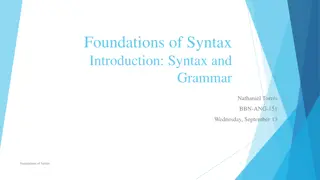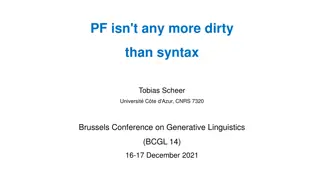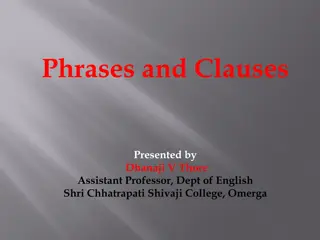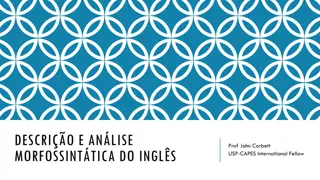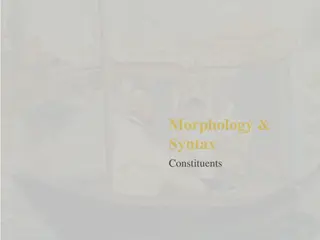Understanding Compound Words and Phrases in Morphology & Syntax
Exploring the differences between compound words and phrasal words in linguistics, this content delves into how roots combine to form compounds and how phrasal words function syntactically. Through examples like "green house" versus "greenhouse," as well as stress and semantic criteria, the distinction between compounds and phrases becomes clearer. Additionally, it discusses compound verbs and the various types that exist in language formation.
Download Presentation

Please find below an Image/Link to download the presentation.
The content on the website is provided AS IS for your information and personal use only. It may not be sold, licensed, or shared on other websites without obtaining consent from the author. Download presentation by click this link. If you encounter any issues during the download, it is possible that the publisher has removed the file from their server.
E N D
Presentation Transcript
Ch6 Compound words, Blends and Phrasal words ENGT 243 Morphology & Syntax
6.1 Compounds versus phrases Compounds, words formed by combining roots. Phrasal words, items that have the internal structure of phrases but function syntactically as words How can we tell, then, whether a pair of such roots constitutes a compound word or a phrase that is a unit of sentence structure rather than a complex word ?
6.1 Compounds versus phrases A definite answer is not always possible, but there are enough clear cases to show that the distinction between compounds and phrases is valid. Consider the expressions a green house, with its literal meaning. Vs. a greenhouse, meaning a glass structure (not usually green in colour!) where delicate plants are reared.
6.1 Compounds versus phrases I. There is a difference in sound corresponding to the difference in meaning. (Stress) Phrases Compounds (1) black board vs. blackboard board that is black board for writing on (2) silk worm vs. silkworm worm made of silk (e.g. a soft toy) caterpillar that spins silk (3) hair net vs. hairnet net made of hair net for covering hair (4) white house vs. (the) White House house that is white residence of the US President (5) toy factory vs. toy factory factory that is a toy factory where toys are made
6.1 Compounds versus phrases II. Apart from stress, a second criterion traditionally used for distinguishing compounds from phrases is semantic: a compound tends to have a meaning that is more or less idiosyncratic or unpredictable. This is true of most of the compounds in (1) (5). This criterion must be treated with caution. ? All the same, words (compound words) are more likely to be lexical items than phrases are.
6.2 Compound verbs Verbs formed by compounding are much less usual than verbs derived by affixation. A variety of types exist according to their structure: (6) verb verb (VV): stir-fry, freeze-dry (7) noun verb (NV): hand-wash, air-condition, steam- clean (8) adjective verb (AV): dry-clean, whitewash (9) preposition verb (PV): underestimate, outrun, overcook
6.2 Compound verbs Only the PV type is really common. For example, - out- can create a transitive verb meaning outdo in Xing from any verb denoting a competitive or potentially competitive activity (e.g. outsail, outsing, outswim). - new words with over- can also be created freely (e.g. overpolish, overcriticise, overbleach).
6.2 Compound verbs You will notice that - All these compounds have a verb as the rightmost element. - ALSO The activity denoted by the compound as whole is a variety of the activity denoted by that rightmost element. These compounds are right-headed, the rightmost element being the head. Most English compounds are right-headed, but not all, as we shall see in Section 6.6.
6.3 Compound adjectives Examples of right-headed compound adjectives: (10) noun adjective (NA): sky-high, coal-black, oil-rich (11) adjective adjective (AA): grey-green, squeaky-clean, red- hot (12) preposition adjective (PA): underfull, overactive It is the type with the preposition over as its first element that seems most productive, with the meaning too X overindignant, oversmooth.
6.3 Compound adjectives In overactive at (12), the head of the compound is the adjective active derived from the verb act. In structure This adjective is not a mere string of morphemes (over + act + -ive), but rather a nested structure: [over[act-ive]].
6.3 Compound adjectives Corresponding to the VV verbs at (2), adjectives with a VA structure would resemble a hypothetical - float-light light enough to float - sing-happy happy enough to sing . One actual example fail-safe designed to return to a safe condition if it fails or goes wrong . However, other such compounds hardly exist, even though it is easy enough to find plausible meanings for them. This reflects the relative reluctance of verbs to participate in compounding generally in English.
6.3 Compound adjectives All the compounds in (10) (12) are right- headed. There are also a few compound adjectives that are not right-headed, but we will discuss them along with all headless compounds in Section 6.5.
6.4 Compound nouns It is with nouns that compounding really comes into its own as a word forming process in English. Examples (13) verb noun (VN): swearword, drophammer, playtime (14) noun noun (NN): hairnet, mosquito net, butterfly net, hair restorer (15) adjective noun (AN): blackboard, greenstone, faintheart (16) preposition noun (PN): in-group, outpost, overcoat
6.4 Compound nouns All of these have the main stress on the left a characteristic identified in Section 6.1 as important for distinguishing compound nouns from noun phrases. (The fact that hair restorer, butterfly net and mosquito net are spelled with a space does not affect the fact that, from the grammatical point of view, they each constitute one complex word.) Most of these are also right-headed,
6.4 Compound nouns Consider the four examples at (14). hairnet, mosquito net, butterfly net, hair restorer Does each one have a precise interpretation that is clearly the most natural, on the basis of the meanings of their two components? For hair restorer, the answer is surely yes: it most naturally denotes a substance for restoring hair growth. On the other hand, for hairnet, butterfly net and mosquito net the answer is less clear.
6.4 Compound nouns A hairnet is for keeping one s hair in place A butterfly net is for catching butterflies A mosquito net is for keeping mosquitoes away? This information does not reside in the meaning of net, nor in the meanings of hair, butterfly and mosquito. The most that one can conclude from these individual meanings is that each is a net that has something to do with hair, butterflies and mosquitoes respectively.
6.4 Compound nouns Arriving at the precise meanings of these compounds depends on our knowledge of the world (that some people collect butterflies, and that mosquitoes can carry disease) rather than on purely linguistic knowledge. The difference in precision with which we can interpret hair restorer on the one hand and hairnet etc.
6.4 Compound nouns restorer in hair restorer is derived from a verb (restore) Verbs impose expectations and requirements on the noun phrases that accompany them in the sentence. For example, sleep John sleeps NP as a S eat John eats strawberries NP as an O give John gave Anne the book. NP as an Od These expected or required nominal concomitants to a verb are called its arguments
6.4 Compound nouns When the head of a NN compound is derived from a verb, as restorer is, the most natural way to interpret the whole compound is quite precise: The first element (hair) expresses the object argument of the verb (restore) (that is, the person or thing that undergoes the action).
6.4 Compound nouns Here are some more compounds whose second element is derived from a verb: (17) sign-writer, slum clearance, crime prevention, wish-fulfilment The most natural interpretation is clear. Crime prevention means prevention of crime X The meaning use of crime for preventive purposes seems contrived and unnatural.
6.4 Compound nouns Primary Compounds NN compound like hairnet or mosquito net The right-hand noun is not derived from a verb and whose interpretation is not precisely predictable on a purely linguistic basis, a primary or root compound. Secondary Compounds NN compound like hair restorer or slum clearance The first element is interpreted as the object of the verb
6.4 Compound nouns Although verbs are relatively rare as elements in compounds in English (the swearword pattern is unusual), Verbal compounds, in the sense just defined, are common. Secondary compounds are certainly right-headed Crime prevention denotes a kind of prevention Wish-fulfilment denotes a kind of fulfilment. In this respect they are like most NN compounds and most compounds generally but not all.
6.4 Compound nouns Although verbs are relatively rare as elements in compounds in English (the swearword pattern is unusual), Verbal compounds, in the sense just defined, are common. Secondary compounds are certainly right-headed Crime prevention denotes a kind of prevention Wish-fulfilment denotes a kind of fulfilment. In this respect they are like most NN compounds and most compounds generally but not all.
Headed and headless compounds Greenstone is a kind of stone Blackboard is a kind of board Faintheart is not a kind of heart but a kind of person. Although heart is a noun, it is not appropriate to call heart the head of the compound. Rather, faintheart is headless, in the sense that its status as a noun is not determined by either of its two components.
Headed and headless compounds A few VN-type compound nouns resemble secondary compounds in that the noun at the right is interpreted as the object of the verb: (18) pickpocket, killjoy, cutpurse These are headless. Why? A pickpocket is not a kind of pocket.
1. Headless compounds The fact that heart and pocket are nouns is really irrelevant to the fact that faintheart and pickpocket are nouns too. We should expect there to be some headless nouns in which the second element is not a noun at all. Also, headless adjectives in which the second element is not an adjective.
2. Headless compounds Some nouns consist of a verb and a preposition or adverb: (19) take-off, sell-out, wrap-up, sit-in The nouns at (19) can be seen as a case of conversion, where the base is a verb + another word (sometimes constituting a lexical item), as illustrated in (20): (20) a. The plane took off at noon. b. The chairman wrapped the meeting up. c. The students sat in during the discussion.
3. Headless compounds As for headless adjectives, there are quite a number consisting of a preposition and a noun: (21) overland, in-house, with-profits, offshore, down-market, upscale, underweight, over-budget The adjectival status of these compounds can often be confirmed by their appropriateness in comparative contexts and with the modifier very: (22) a. They live in a very down-market neighborhood. b. This year s expenditure is even more over-budget than last year s
Headed and headless compounds The fact that the word class of these headless compounds is not determined by any element inside them has led some grammarians to call them exocentric. (Having a centre outside themselves, figuratively speaking.) According to this approach, headed compounds would be regarded as having an internal centre ; and, sure enough, they are sometimes called endocentric.
Compounding 1. Endocentric Compounds a. frying pan dancing shoes b. pan opener candlestick maker - Their meaning can be inferred from the meaning of the words they contain. - The word on the left serves as a modifier.
Compounding 2. Exocentric compounds Green tax (N) Greenhouse (N) Cold turkey (N) Bag lady (N) Golden handcuffs (N) Stonewall (verb) Cold shoulder (V,N) Carbon footprint (N) The meaning is not compositional. They must be listed in the lexicon. They must be memorized.
Compounding 3. Endocentric OR Exocentric (According to context) Knee-deep (adj.) can mean - sunk right up the knees (literally) compositional meaning endocentric - deeply involved with (figurative) noncompositional exocentric
Blends and acronyms Blends: a kind of compound where at least one component is reproduced only partially. smog, blended from smoke and fog; Partial blends, where only one component is truncated talkathon (from talk plus marathon) cheeseburger (from cheese plus hamburger).
Blends and acronyms Acronyms: a kind of truncation that a component of a blend can undergo reduction to just one sound (or letter), usually the first. (Blends made up of initial letters) ANZAC (for Australian and New Zealand Army Corps) RAM (for random access memory) SCSI (pronounced scuzzy, from small computer systems interface) AIDS (from acquired immune deficiency syndrome) Intermediate between an acronym and a blend is sonar (from sound navigation and ranging). NATO (for North Atlantic Treaty Organisation)
Blends and acronyms Not any string of capital letters represents an acronym. If the conventional way of reading the string is by pronouncing the name of each letter in turn, as with USA and RP (standing for the Received Pronunciation of British English), then it is not an acronym but an abbreviation.
Blends and acronyms Blending and acronymy are in active use for the creation of new vocabulary. However, they differ from derivational affixation and normal compounding in being - more or less self-conscious, - and are concentrated in areas where the demand for new noun vocabulary is greatest, such as (currently) information technology.
Compounds containing bound combining forms Most of the compounds that we have looked at so far involve roots that are free forms. But the vocabulary of English, especially in scientific and technical areas, includes a huge repertoire of compounds that are made up of bound roots, known as combining forms, (23) anthropology, sociology, cardiogram, electrocardiogram, retrograde, retrospect, plantigrade
Compounds containing bound combining forms For most of these, the meaning of the whole is clearly determinable from that of the parts. anthrop(o)- human + -(o)logy science or study science or study of human beings planti- sole (of foot) + -grade walking walking on the soles of the feet . This semantic predictability is crucial to the coining of new technical terms using these elements.
Phrasal words In some of the compounds, relationships are expressed are the same as ones expressed in syntax: the verb object relationship between hair and restore in hair restorer
Phrasal words The way in which the verb object relationship is expressed in a compound is quite different from how it is expressed in syntax. The two words appear in the opposite order. This substance restores hair (sentence structure) NOT *This substance hair-restores.(compound word structure) There is a clear difference between compound word structure and sentence structure
Phrasal words There are also complex items that function as words, yet whose internal structure is that of a clause or phrase rather than of a compound. phrasal words jack-in-the-box noun
The noun jack-in-the-box Structurally has the appearance of a noun phrase parallel to the phrases people in the street or (a) book on the shelf
However it forms its plural by suffixing -s NOT to the head noun As in (books on the shelf )
but to the whole expression: jack-in-the-boxes as in They jumped up and down like jack-in-the-boxes. NOT X jacks-in-the-box Though structurally a phrase, it behaves as a word.
brother-in-law forms its plural by affixing -s not to the whole expression but to the head noun: brothers-in-law.
Despite its hyphens brother-in-law is NOT a word but a phrase (although also a lexical item)
Phrasal words Can phrases other than noun phrases constitute phrasal words?
The answer is yes. Adjectival examples dyed-in-the-wool (a dyed-in-the- wool Republican) couldn t-care-less (a couldn t-care-less attitude)
Syntactically, dyed-in-the-wool looks like an adjective phrase consisting of an adjective modified by a prepositional phrase just like suitable for the party devoted to his children
However, such a phrase cannot entirely precede the noun it modifies. *a devoted to his children man *suitable for the party music we say a man devoted to his children Or suitable music for the party
